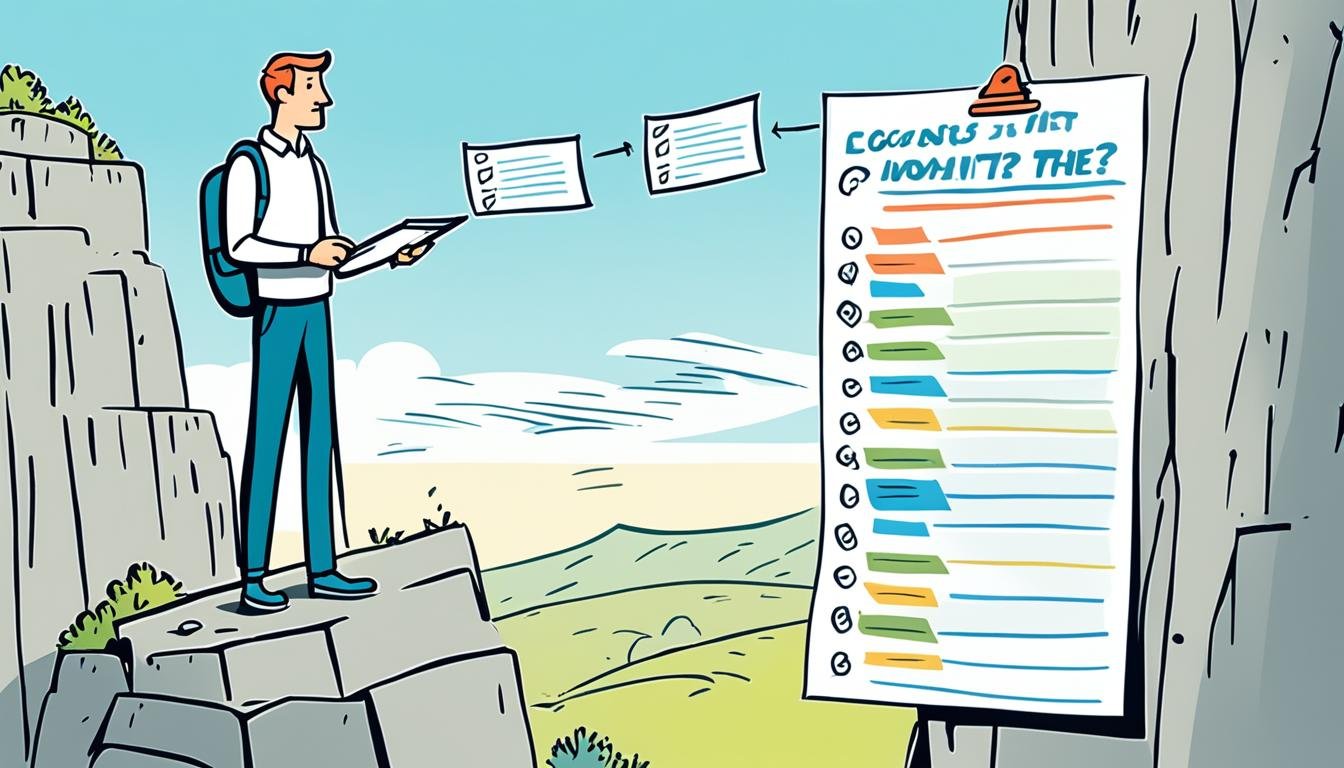Leadership Productivity Hacks: Maximizing Efficiency
“Productivity is never an accident. It is always the result of a commitment to excellence, intelligent planning, and focused effort.” – Paul J. Meyer
Leaders often strive to be more productive. They want to lead their team effectively and get great results. To do this, they use smart strategies and tools. These help them be the best leaders they can be.
Now, let’s look at some special tips just for leaders. We will talk about setting clear goals and managing time wisely. Also, we’ll discuss how to form good work routines and keep learning. These tips will change how you lead, making you way more efficient.
Set Clear Goals and Priorities
Setting clear goals and prioritizing tasks is key to being a great leader. It applies whether you’re running a team, a project, or trying to grow your company. Clear goals guide everyone, helping to stay focused. By splitting big goals into smaller steps, your actions match your organization’s main goals.
Goals should be clear, measurable, and doable. Clear goals help you understand and gauge progress and success. Prioritize tasks by their importance and need for speed. This way, everything you do pushes your organization forward.
Breaking Down Goals
Breaking goals into smaller tasks makes them easier to handle. It shows you the path forward and keeps you on track. By figuring out each key step, you can focus on what really matters and make sure every task helps meet your big goals.
“By breaking down your goals into smaller, actionable tasks, you not only make them more achievable but also create a clear path towards success.” – John Maxwell
Prioritizing Tasks
Choosing the most important tasks to work on first is crucial. Knowing what’s urgent or key in each task saves time and effort. This way, you work effectively towards your major targets. It stops you from feeling swamped and lets you feel good as you move closer to your goals.
To prioritize, think about the tasks’ importance and when they need to be done:
| Task | Importance | Urgency |
|---|---|---|
| Create marketing campaign | High | High |
| Respond to client inquiries | High | Medium |
| Review employee performance | Medium | Low |
| Attend team meeting | Low | High |
By ranking tasks by importance and urgency, you focus on the most important and pressing ones first. This keeps you on course towards your big objectives.
Master Time Management
Time management is key for leaders. It boosts productivity and success. Leaders use various techniques to manage their time well and get better results.
Time Blocking
Time blocking means dividing your day into blocks for different tasks. This stops multitasking, which can lower productivity and cause stress. Leaders get more done by setting specific times for each job.
They might plan strategically in the morning and hold team meetings in the afternoon. This method keeps them focused on important tasks.
Eisenhower Matrix
The Eisenhower Matrix helps manage tasks by importance and urgency. It guides leaders on what to do first.
“What is important is seldom urgent, and what is urgent is seldom important.” – Dwight D. Eisenhower
Tasks are split into four groups: urgent and important, important but not urgent, urgent but not important, and not urgent or important.
By recognizing urgent but unimportant tasks, leaders can better allocate their time. This ensures more important tasks get done first.
Pomodoro Technique
The Pomodoro Technique focuses on short, intense work periods with breaks. It employs a 25-minute timer for work sessions called “pomodoros,” followed by a break.
It helps prevent burnout and keeps concentration high. Leaders work on one task at a time, boosting their efficiency.
These methods, like time blocking, the Eisenhower Matrix, and the Pomodoro Technique, help leaders manage their time well. They lead to better decision making, task prioritization, and increased productivity. Using these strategies, leaders can meet their goals despite time pressures.
Establish Efficient Work Habits
For any organization’s success, creating a culture of efficiency is key. Leaders can do this by adopting productive work habits, reducing distractions, and leading by good example. This helps build a work environment that values getting things done and improving team performance.
Leaders should make time for focused work to establish efficient work habits. They can do this by setting schedules or using time-blocks for important tasks. By working on tasks without any breaks or diversions, they can boost their work output.
It’s critical to minimize distractions. Leaders must ask their team to cut back on things like phone alerts, unused computer tabs, or noisy work areas. This way, everyone can concentrate better which leads to more work done well.
Setting a good example is crucial. When leaders show they are dedicated to being productive and cutting distractions, they encourage their team members to do the same. This consistent behavior creates a work culture where being productive is a top priority.
Productive work habits are not only on the individual but also a team effort. Leaders should promote open talks, give needed tools for work, and support their team when necessary. A productive work environment encourages everyone to strive for success.
| Benefits of Establishing Efficient Work Habits |
|---|
| Increased productivity |
| Improved focus and concentration |
| Higher quality of work |
| Enhanced time management |
| Reduced stress levels |
| Greater work-life balance |
Embrace Continuous Learning
For leaders, investing in ongoing learning is vital. It helps them stay up-to-date and effective in a fast-changing world. As they grow their skills and knowledge, they boost their leadership impact. This also spurs growth in their teams.
Personal and professional development comes in many forms. You can learn in various ways, such as:
- Workshops and seminars provide insights from experts.
- Online courses allow flexibility, letting you learn at your own pace.
- Reading about your industry’s newest ideas keeps you informed.
Actively looking for chances to grow betters a leader’s abilities. It lets them take on new challenges and pursue fresh opportunities. This pushes not only their personal success but also contributes to a team culture centered on learning and advancement.
“The more that you read, the more things you will know. The more that you learn, the more places you’ll go.” – Dr. Seuss
But learning doesn’t stop at gaining new facts and skills. True continuous learning means using and sharing what you’ve learned to make a difference. Leaders who are committed to always learning set an example for their teams. They show the importance of ongoing self-improvement and inspire others to do the same.
The Benefits of Lifelong Learning
For leaders, lifelong learning has many advantages:
- Professional growth: It keeps you current with the latest trends and practices.
- Personal growth: It makes you understand yourself better and improve your leadership skills.
- Adaptability: It helps you face new challenges with confidence.
- Enhanced decision-making: More knowledge means better choices for your team.
- Innovation: It sparks creativity and new ideas in your work.
Choosing to keep learning is a smart move for leaders who want to get ahead. It’s not just about enhancing your skills and knowledge. It’s also about fostering a culture of growth and learning in your team. This foundation is key to long-term success.
Personal and Professional Development: Key Takeaways
- It’s essential for leaders to keep developing, to remain effective and relevant.
- Long-term learning happens through many means, like courses, workshops, and reading.
- It boosts both professional and personal growth, and helps with facing new challenges.
- Learning continuously lays the groundwork for ongoing success in teams and organizations.
Delegate Effectively
Delegation is key to being a great leader. It allows leaders to focus on important decisions. It also helps team members grow and learn. Leaders give tasks to others and make sure they have what they need to do well. This boosts team work and gets more things done.
When passing on tasks, knowing your team’s strengths is crucial. Tasks should match the skills and passions of team members. This helps them feel like the work is theirs. It makes them really involved and hungry to learn and improve.
“Successful delegation is not about merely assigning tasks; it is about empowering and enabling others to contribute their best. It is a process that involves clear communication, setting expectations, providing support and guidance, and trusting your team.”
Delegating makes team members feel trusted and capable. When they get to show what they can do, they feel happy and ready to do more. This boosts how well they work and come up with new ideas.
Also, delegation helps team members grow in their jobs. Trying new tasks helps them learn and get better. This gets them ready for leading in the future.
Benefits of Effective Delegation:
- Optimized time management and increased efficiency
- Enhanced employee engagement and motivation
- Improved collaboration and teamwork
- Accelerated professional growth and skill development
- Cultivation of a culture of trust and ownership
Delegating well empowers teams and drives success. It’s about more than just dishing out work. It’s about building up the organization and everyone in it.
We’ve seen that delegating is a big plus for leaders. Next, let’s talk about another important leadership skill. Creating a work environment that’s positive and motivating.
Cultivate a Positive Work Environment
It’s vital for leaders to create a positive work setting. This type of environment greatly impacts how motivated and satisfied employees are. If workers feel their efforts are valued, they do more and help the organization succeed.
A good method to boost positivity is to celebrate wins. Recognizing what team members achieve lifts spirits and promotes a thankful culture. By marking both small and big wins, you show that effort is noticed and appreciated, spurring others to do their best.
Giving helpful feedback is also key. When leaders offer feedback that’s about growth, employees feel their bosses really care. Such talks help people learn more and make the most of their abilities.
Keeping channels of communication open is vital for a happy workplace. It makes employees feel included and empowered. This, in turn, makes them more eager to help their team and company succeed.
Clear communication eases collaboration and problem-solving. It lets team members share ideas without fear. This boosts innovation and makes the workplace run more smoothly.
Setting up communication tools like regular meetings and suggestion boxes is important. They help voices be heard. Also, an honest and trusting work culture encourages people to speak up, making everyone feel involved.
Building a good workplace takes ongoing effort from bosses. By celebrating success, offering feedback, and having strong communication, you can unite and inspire your team. This leads to better productivity and new ideas.
| Benefits of a Positive Work Environment | Actions to Cultivate a Positive Work Environment |
|---|---|
| 1. Increased employee motivation | 1. Recognize and celebrate achievements |
| 2. Higher productivity levels | 2. Provide constructive feedback |
| 3. Enhanced job satisfaction | 3. Establish open communication channels |
| 4. Improved employee retention | 4. Encourage collaboration and teamwork |
| 5. Greater innovation and creativity | 5. Foster a culture of transparency and trust |
Prioritize Self-Care
It’s vital to put self-care first, especially for leaders. Leaders are often busy and can forget about themselves. This might lead to burnout and working less effectively. By focusing on work-life balance and looking after our physical and mental health, we can be at our peak. This also shows our teams a positive example.
One crucial part of self-care is keeping a good work-life balance. Make sure to have a life outside of work. Spend time with family and friends, enjoy hobbies, or just relax. This time away from work is key to preventing burnout and boosting happiness.
Enough sleep is also vital for self-care. Good sleep helps our body and mind. It boosts focus, concentration, and brain power. Leaders who sleep well can make better decisions. They should stick to a sleep schedule and create a good sleeping space for the best rest.
Activities that refresh us beyond work are important too. These can be exercise, spending time outdoors, or doing creative things. Engaging in such activities helps us take a break from work. They also lower stress and make us feel better.

Don’t forget, taking care of yourself matters for being a good leader. It shows in our leadership and helps build a great working environment.
By focusing on self-care and balance, leaders can work better and inspire others. Remember, a leader who cares for themselves does better work. They lead with energy and clarity.
Leveraging Technology
Technology has changed how we work for the better. It helps leaders make their teams work better and faster. They use new tech and apps to boost their efficiency and lead their teams to success.
Productivity Apps: The Key to Streamlined Workflows
Productivity apps are now a must-have for leaders. They include tools for managing tasks, working together, and tracking time. These features help make work smoother and more efficient.
Tasks like project management and tracking progress become easier. Thanks to these apps, leaders can be more organized, ensuring nothing is overlooked.
“Productivity is never an accident. It is always the result of a commitment to excellence, intelligent planning, and focused effort.” – Paul J. Meyer
Leaders use these apps to assign tasks, set deadlines, and follow progress. This keeps the project in check and everyone accountable. The apps also boost teamwork and open communication.
The Power of Meditation Apps
Leaders face a lot of stress today and need to find their calm. Meditation apps help by offering sessions and techniques for relaxation. They help leaders unwind, think clearly, and feel better.
Regular meditation helps leaders make better decisions, handle stress, and keep a positive outlook. These apps make mindfulness easy, enhancing productivity and well-being.
Embrace the Latest Technological Tools
To be ahead, leaders must try the newest tech tools. Things like project software and online teamwork platforms change how teams operate. Leaders can boost productivity and make work easier by using these.
Exploring the latest tech trends lets leaders do more with less effort. As AI and machine learning grow, leaders can find new ways to compete and innovate.
Using technology is a journey for better work and leadership. With the right apps and new tech, leaders can manage time better and guide their teams to success in our digital world.
Continuous Learning and Skill Development
Growth is key for leaders aiming to boost work quality and keep up in business. They can do this by attending workshops, webinars, and conferences. These events let them learn from top experts, pick up new ideas, and meet others in their field. Also, reading books and articles helps them learn and come up with new concepts.
Taking online courses and earning certifications is another way to learn constantly. Online sites offer a lot of courses for various professional goals and hobbies. From improving leadership to learning new tech, online classes offer a flexible approach that adapts to busy lives. The option to learn anywhere lets leaders join in when it suits them best.
Learning all the time not only makes leaders better but also improves team performance and encouragement for growth. By keeping up with the latest trends and gaining new skills, leaders show their teams the way to a growing, learning culture. Making a point to grow both professionally and personally by attending workshops, online classes, and other sources is an investment in future success for leader and their team.
| Benefits | Description |
|---|---|
| 1. Enhanced Competency | With continuous learning, leaders have the newest skills and strategies to handle issues better. |
| 2. Increased Adaptability | Leaders open to continuous learning can better handle fast business changes and find creative solutions. |
| 3. Improved Decision-Making | By always learning, leaders broaden their viewpoints, helping them make better decisions with more info. |
| 4. Cultivation of Creativity | Learning new skills and exploring ideas sparks creativity and helps leaders consider new solutions. |
| 5. Supportive Team Culture | Leaders promoting their learning inspire team members to do the same, creating a team culture focused on growth and learning. |
Conclusion
Adding certain productivity tips to your routine can bring big outcomes. It is about knowing how to manage your time and what tasks to focus on. You also need to build good work habits, use tools wisely, take care of yourself, and always be ready to learn.
This full look at productivity helps you work better and still have time for life outside work. These methods help you do your best, lead your team, and move closer to your dreams.
Leadership productivity is more than just being busy. It’s about being clever and aiming for long-term wins. By taking care of yourself, welcoming change, and using clever methods, you can lead in a way that lifts others up too.
FAQ
What are some effective leadership strategies for boosting productivity?
Effective leadership in increasing productivity involves several steps. This includes setting clear goals and knowing your priorities. It’s about time management and efficient work habits. Leaders should always be learning, delegate well, and create a positive work setting. Self-care and using technology wisely are also key. Finally, leaders must never stop working on personal and professional growth.
How can setting clear goals and priorities enhance productivity?
Clear goals and priorities ensure everyone works towards the same goals. It highlights the most important tasks. This makes sure each action helps the organization succeed.
What time management techniques can leaders utilize to optimize productivity?
Leaders can improve productivity with specific time management methods. These include time blocking, the Eisenhower Matrix, and the Pomodoro Technique. These strategies help control time and boost efficiency.
How can leaders establish efficient work habits?
Efficient work habits start with avoiding distractions. They mean having focused work time which the leader shows is important. Encouraging an efficient culture inside the team is crucial. This boosts everyone’s productivity.
Why is continuous learning important for leaders?
Learning from workshops, courses, and books makes leaders better. It helps them grow and leads to more success for the team. Leaders who keep learning are always improving.
How can delegation contribute to effective leadership?
Delegation lets leaders focus on the most important tasks. It gives others a chance to grow and show their skills. This helps the team work better together.
How can leaders cultivate a positive work environment?
Creating a positive space at work involves recognizing effort and giving feedback. Good communication is also important. This supports a team that is motivated and works well together.
Why is prioritizing self-care important for leadership productivity?
Leaders should take care of themselves to be better at their jobs. This means a good balance between work and life. It ensures they are focused and effective in their roles.
How can leaders leverage technology to enhance productivity?
Technology can help leaders stay productive. There are apps for better work, meditation, and organization. Exploring new tools and technologies can greatly improve how we work.
Why is continuous learning and skill development important for leaders?
Learning never stops for a good leader. Workshops, webinars, and more help them stay sharp. Enrolling in courses and getting certifications enhances their abilities. This leads to better performance.
How can leaders maximize efficiency and achieve work-life balance?
To balance work and life, leaders should focus on productivity and good habits. They can use technology wisely and continue to learn. Self-care is also vital. These steps help them be the best they can be while maintaining a healthy lifestyle.
Source Links
- https://www.linkedin.com/pulse/productivity-hacks-maximizing-efficiency-achieving-work-life
- https://www.linkedin.com/pulse/maximizing-leadership-productivity-7-essential-tips-j-andy-newsom-okj9e
- https://www.forbes.com/sites/jiawertz/2023/12/22/5-productivity-hacks-and-the-art-of-mastering-efficiency/








